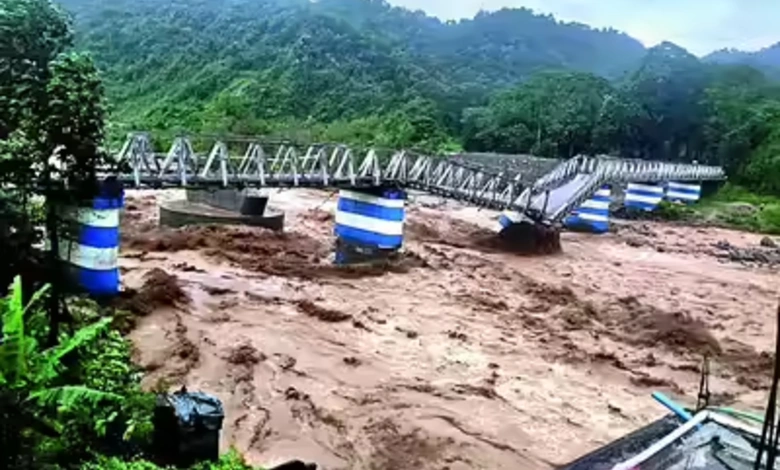
Intense rainfall overnight triggered devastating landslides and flash floods across northern Bengal, claiming at least 28 lives predominantly in the scenic hill outpost of Mirik and leaving dozens unaccounted for amid rescue efforts hampered by severed access routes. Collapsed bridges have marooned communities and trapped hundreds of visitors, while authorities scramble to restore order. West Bengal Chief Minister Mamata Banerjee pledged swift aid, as major rivers surge beyond safe marks and wildlife scatters from inundated woodlands.
The barrage of precipitation battered the hilly and lowland districts from Saturday evening into Sunday dawn, spawning chaos from Darjeeling to Cooch Behar through mudslides that demolished infrastructure and submerged settlements. Rescue squads faced formidable obstacles in accessing isolated locales amid the widespread inundation. Rainfall totals were staggering: Darjeeling measured 261 mm over 24 hours starting at 8 a.m. Saturday deemed “extremely heavy” with Cooch Behar at 192 mm, Jalpaiguri at 172 mm, and Gajoldoba in Jalpaiguri hitting a peak of 300 mm.
Epicenters of destruction included Mirik, Jorebunglow, Maneybhanjang, Sukhiapokhri, and Falakata. In Mirik, famed for Sumendu Lake and panoramic vistas of Kanchenjunga, rescuers recovered 13 corpses, while 10 individuals including Kolkata visitor Himadri Purkayet remained absent by Sunday dusk. Authorities cautioned that the death count could climb as teams penetrate higher elevations. Prime Minister Narendra Modi conveyed sorrow via social media: “Deeply pained by the loss of lives due to a bridge mishap in Darjeeling… The situation is being closely monitored in the wake of heavy rain and landslides. We are committed to providing all possible assistance.”
Vital transport arteries crumbled under the assault: The iron span over the Balasan River at Dudhia the sole straight path linking Siliguri and Mirik gave way, stranding local populations. A span at Pulbazar suffered severe impairment, severing Thanaline and segments of Bijanbari. Rohini Road, a key thoroughfare from Darjeeling to lower ground, subsided entirely. National Highway 10, essential for Sikkim access, closed at Chitrey due to debris flows, and the Darjeeling Himalayan Railway halted operations without a resumption timeline.
What began as leisurely post-Durga Puja getaways devolved into perilous ordeals for visitors in Dooars, Kalimpong, and Darjeeling, confined to elevated lodgings and nature reserves amid blackouts, spotty signals, and eroded paths. Some improvised with aerial cables or cords to ford raging streams. “Water currents were so strong we had to form a human chain,” recounted Priya Banerjee, a Kolkata local who trekked four hours to secure transport. In Sisamara, entrepreneur Saurav Palit and relatives trudged 6 km through sludge and surges, then shelled out Rs 4,000 for a brief ride to Falakata. At Jaldapara, groups forded chest-high floods to safety, with select evacuations via safari elephants. “We were stranded all day before forest officials brought elephants used for safaris to take us through flooded rivers to safer ground,” related Senjuti Ghosh, a Kolkata native bunking in an Alipurduar inn pending her Tuesday evening rail departure. Officials shuttered every attraction and implored sightseers to remain stationary pending aid. Darjeeling Superintendent of Police Praween Prakash advised monitoring law enforcement alerts online: “Check advisories before venturing out.”
Disruptions cascaded outward, with travelers bound for New Jalpaiguri railway hub and Bagdogra airfield forfeiting departures. Banerjee convened a crisis video huddle with senior administrators and local figures like Siliguri Mayor Gautam Deb and Gorkhaland Territorial Administration head Anit Thapa, signaling a Monday inspection tour. “Several areas in both north and south Bengal have been flooded due to sudden huge rain and excessive river waters from Bhutan and Sikkim,” she shared on X. “Rainfall exceeded 300mm in 12 hours last night. I convey my heartfelt condolences to the families of the deceased and have ordered immediate assistance.” She mandated shutdowns of all leisure venues in impacted zones, disseminated crisis hotlines from Nabanna headquarters, and vowed state coverage of extraction expenses.
Come Sunday midday, Indian Army detachments and National Disaster Response Force (NDRF) contingents augmented provincial responders in salvage and repair drives. As the Mahananda, Jaldhaka, and Teesta waterways crested perilously, herds of elephants, rhinos, deer, and bison bolted from drowned thickets.




